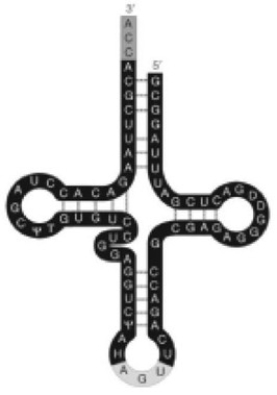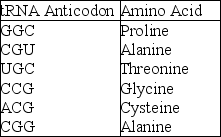A) tRNA with attached lysine (#1)
B) tRNA with polypeptide (#2)
C) tRNA that no longer has attached amino acid
D) newly formed polypeptide
E) initiation and elongation factors
G) B) and E)
Correct Answer

verified
Correct Answer
verified
Multiple Choice
Put the following events of elongation in prokaryotic translation in chronological order. 1) Binding of mRNA with small ribosomal subunit 2) Recognition of initiation codon 3) Complementary base pairing between initiator codon and anticodon of initiator tRNA 4) Base pairing of the mRNA codon following the initiator codon with its complementary tRNA 5) Attachment of the large subunit
A) 1, 2, 3, 4, 5
B) 2, 1, 4, 3, 5
C) 5, 4, 3, 2, 1
D) 1, 2, 3, 5, 4
F) A) and C)
Correct Answer

verified
Correct Answer
verified
Multiple Choice
Which of the following occurs in prokaryotes but not in eukaryotes?
A) post-transcriptional splicing
B) concurrent transcription and translation
C) translation in the absence of a ribosome
D) gene regulation
F) C) and D)
Correct Answer

verified
Correct Answer
verified
Multiple Choice
A mutant bacterial cell has a defective aminoacyl-tRNA synthetase that attaches a lysine to tRNAs with the anticodon AAA instead of the normal phenylalanine. The consequence of this for the cell will be that ________.
A) none of the proteins in the cell will contain phenylalanine
B) proteins in the cell will include lysine instead of phenylalanine at amino acid positions specified by the codon UUU
C) the cell will compensate for the defect by attaching phenylalanine to tRNAs with lysine-specifying anticodons
D) the ribosome will skip a codon every time a UUU is encountered
F) A) and B)
Correct Answer

verified
Correct Answer
verified
Multiple Choice
During elongation, which site in the ribosome represents the location where a codon is being read?
A) E site
B) P site
C) A site
D) the small ribosomal subunit
F) None of the above
Correct Answer

verified
Correct Answer
verified
Multiple Choice
The anticodon of a particular tRNA molecule is ________.
A) complementary to the corresponding mRNA codon
B) complementary to the corresponding triplet in rRNA
C) the part of tRNA that bonds to a specific amino acid
D) changeable, depending on the amino acid that attaches to the tRNA
E) catalytic, making the tRNA a ribozyme
G) All of the above
Correct Answer

verified
Correct Answer
verified
Multiple Choice
In an experimental situation, a student researcher inserts an mRNA molecule into a eukaryotic cell after she has removed its 5' cap and poly-A tail. Which of the following would you expect her to find?
A) The mRNA is quickly converted into a ribosomal subunit.
B) The cell adds a new poly-A tail to the mRNA.
C) The mRNA attaches to a ribosome and is translated, but more slowly.
D) The molecule is digested by enzymes because it is not protected at the 5' end.
F) A) and D)
Correct Answer

verified
Correct Answer
verified
Multiple Choice
Use this model of a eukaryotic transcript to answer the following question(s) . -When the spliceosome binds to the transcript shown above, it can attach ________.
A) to the exons
B) to the 5' UTR
C) to the 3' UTR
D) at certain sites along an intron
F) None of the above
Correct Answer

verified
Correct Answer
verified
Multiple Choice
Which of the following is the first event to take place in translation in eukaryotes?
A) elongation of the polypeptide
B) base pairing of activated methionine-tRNA to AUG of the messenger RNA
C) binding of the larger ribosomal subunit to smaller ribosomal subunits
D) covalent bonding between the first two amino acids
E) the small subunit of the ribosome recognizing and attaching to the 5' cap of mRNA
G) D) and E)
Correct Answer

verified
Correct Answer
verified
Multiple Choice
Which of the following statements is TRUE about protein synthesis in prokaryotes?
A) Extensive RNA processing is required before prokaryotic transcripts can be translated.
B) Translation can begin while transcription is still in progress.
C) Prokaryotic cells have complicated mechanisms for targeting proteins to the appropriate cellular organelles.
D) Translation requires antibiotic activity.
E) Unlike eukaryotes, prokaryotes require no initiation or elongation factors.
G) A) and C)
Correct Answer

verified
Correct Answer
verified
Multiple Choice
 -In the figure associated with this question, what is the function of the ACC sequence at the 3' end?
-In the figure associated with this question, what is the function of the ACC sequence at the 3' end?
A) It attaches to an amino acid.
B) It base pairs with the codon of mRNA.
C) It stabilizes the tRNA-amino acid complex.
D) It is the active site of this ribozyme.
F) None of the above
Correct Answer

verified
Correct Answer
verified
Multiple Choice
Use the following information to answer the question below.
A part of an mRNA molecule with the following sequence is being read by a ribosome: 5' CCG-ACG 3'(mRNA) . The following charged transfer RNA molecules (with their anticodons shown in the 3' to 5' direction) are available. Two of them can correctly match the mRNA so that a dipeptide can form.
 The anticodon loop of the first tRNA that will complement this mRNA is
The anticodon loop of the first tRNA that will complement this mRNA is
A) 3' GGC 5'
B) 5' GGC 3'
C) 5' ACG 3'
D) 5' UGC 3'
E) 3' UGC 5'
G) A) and B)
Correct Answer

verified
Correct Answer
verified
Multiple Choice
If the sequence in the coding strand of DNA for a particular amino acid is 5'AGT3', then the anticodon on the corresponding tRNA would be ________.
A) 5'ACU3'
B) 5'TCA3'
C) 5'UCA3'
D) 5'AGU3'
F) A) and D)
Correct Answer

verified
Correct Answer
verified
Multiple Choice
What molecules in the spliceosome catalyze the intron removal reactions?
A) RNA polymerases
B) ribozymes
C) tRNA
D) introns
F) A) and B)
Correct Answer

verified
Correct Answer
verified
Multiple Choice
Use the following information to answer the question(s) below. A transfer RNA (#1) attached to the amino acid lysine enters the ribosome. The lysine binds to the growing polypeptide on the other tRNA (#2) in the ribosome already. -Where does tRNA #2 move to after this bonding of lysine to the polypeptide?
A) A site
B) P site
C) E site
D) exit tunnel
E) directly to the cytosol
G) D) and E)
Correct Answer

verified
Correct Answer
verified
Multiple Choice
There are 61 codons that each specify the addition of a specific amino acid, and 3 stop codons for which there is no corresponding amino acid. However, there are only about 40 tRNA molecules, representing 40 anticodons. How is that possible?
A) Only about 40 of the recognized 61 codons are present in mRNA.
B) An anticodon forms hydrogen bonds with the codon; it must match the first two bases of the codon but is less specific with respect to the third base.
C) There are tRNAs that can bind one of two related amino acids.
D) Only 20 of the codons are active-one for each amino acid.
F) A) and C)
Correct Answer

verified
Correct Answer
verified
Multiple Choice
Suppose that an induced mutation removes most of the 5' end of the 5' UTR of an mRNA. What is most likely to happen?
A) Removal of the 5' UTR will have no effect because the exons are still maintained.
B) Removal of the 5' UTR also removes the 5' cap and the mRNA will quickly degrade.
C) The 3' UTR will duplicate and one copy will replace the 5' end.
D) The first exon will not be read because I1 will now serve as the UTR.
F) A) and B)
Correct Answer

verified
Correct Answer
verified
Multiple Choice
An experimenter has altered the 3' end of the tRNA corresponding to the amino acid methionine in such a way as to remove the 3' bases AC. Which of the following hypotheses describes the most likely result?
A) tRNA will not form a cloverleaf.
B) The amino acid methionine will not become covalently bound.
C) The anticodon will not bind with the mRNA codon.
D) The aminoacyl-tRNA synthetase will not be formed.
F) None of the above
Correct Answer

verified
Correct Answer
verified
Showing 41 - 58 of 58
Related Exams